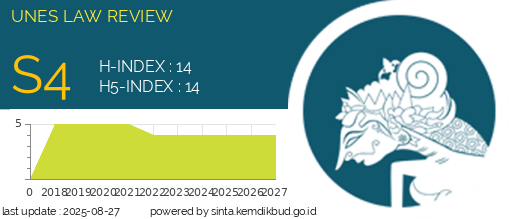ANALISIS YURIDIS LEGALITAS CRYPTOCURRENCY SEBAGAI ALAT PEMBAYARAN DALAM TRANSAKSI BISNIS DI INDONESIA
DOI:
https://doi.org/10.31933/unesrev.v5i4.485Keywords:
IndonesiaAbstract
Abstract The flow of world globalization has greatly impacted technological advances, especially in the payment technology sector which can assist in a fast, safe and secure payment system. At this time we have realized that there is a named currencycryptocurrency, but in Indonesia it has not been regulated concretely regarding the use and legal protectioncryptocurrency. This study aims to examine the regulation of legality and legal protection of cryptocurrencies based on laws and regulations and policies made by the Indonesian government using normative juridical law methods and statutory regulations approaches. Regarding the legal materials used by the authors in the form of primary and secondary legal materials obtained by the authors from books, journals, literature, and data from the Indonesian Government, then the authors analyzed the data using descriptive and legal arguments to obtain systematic and comprehensive research results. Regarding the results of the research, it explains that Cryptocurrency in Indonesia has not been fully regulated, but several rules and policies have been issued by the authorities. Bank Indonesia prohibits the use of Cryptocurrency as a legal means of payment, but the use of Cryptocurrency as a digital asset is still permitted. Bappebti regulates Crypto exchanges, DGT regulates taxes on profits from Cryptocurrency transactions, and OJK warns the public about the risks of investing in the Crypto market. The Indonesian government is in the process of regulating cryptocurrencies more comprehensively through revisions to the capital market law and tax laws.
Downloads
References
Sundeep Gantori, Cryptocurrencies, Beneath the Bubble, Switzerland: United Bank of Switzerland, 2017.
Endra Saputra, Dampak Cryptocurrency Terhadap Perekonomian Indonesia, Jurnal Seminar Nasional Royal (SENAR) 2018.
Undang-Undang Nomor 7 Tahun 2011 Tentang Mata Uang.
Asep Zaenal Ausop, Elsa Silvia Aulia, Teknologi Cryptocurrency Bitcoin Untuk Investasi Dan Transaksi Bisnis Menurut Syariat Islam” Jurnal Sosioteknologi 17, No. 1 2018.
Ayke Nuraliati, Peny Cahaya Azwari, Akuntansi Untuk Cryptocurrency, I-Finance: a Research Journal on Islamic Finance 4, no. 2, 2019.
Muhammad Said Honggowongso, Munawir Kholil, Legalitas Bitcoin Dalam Transaksi E-Commerce Sebagai Pengganti Uang Rupiah, Jurnal Privat Law: Surakarta Volum 9 Nomor 1, Juni 2021.
Lihat Kamus Besar Bahasa Indonesia.
Kitab Undang Undang Hukum Perdata.
George Ritzer, Teori Sosiologi Dari Klasik Sampai Perkembangan Terakhir Posmodern, Pustaka Pelajar: Yogyakarta, 2012.
Tiara Dhana Danella, Sihabbudin, Siti Hamidah, Bitcoin Sebagai Alat Pembayaran Yang Legal Dalam Transaksi Online, Brawijaya Law Student Journal 2015.
Shabrina Puspasari, Perlindungan Hukum Bagi Investor Pada Transaksi Aset Kripto Dalam Bursa Berjangka Komoditi, Jurnal Jurist-Diction Volume 3 Nomor 1, Januari 2020.
Negara, H.K, Kewenangan Pembuatan Akta Bagi Notaris Yang Berada Di Daerah Provinsi Hasil Pemekaran, Jurnal Transparansi Hukum, No 2 2018.
Peraturan Bank Indonesia No. 20/6/PBI/2018.
Watung, Kajian Yuridis Mengenai Keberadaan Bitcoin Dalam Lingkup Transaksi Di Indonesia Ditinjau Dari Undang-Undang Nomor 7 Tahun 2011 Tentang Mata Uang.
Pieris, John dan Aryanthi Baramuli. Dewan Perwakilan Daerah Republik Indonesia: Studi Analisis, Kritik dan Solusi Kajian Hukum dan Politik, Jakarta: Pelangi Cendikia, 2006.
R Muhammad Mihradi. Kebebasan Informasi versus Rahasia Negara. Bogor: Ghalia Indonesia, 2011, hal.108.
Downloads
Published
How to Cite
Issue
Section
License
Hak cipta :
Penulis yang mempublikasikan manuskripnya di jurnal ini menyetujui ketentuan berikut:
- Hak cipta pada setiap artikel adalah milik penulis.
- Penulis mengakui bahwa UNES Law Review berhak menjadi yang pertama menerbitkan dengan lisensi Creative Commons Attribution 4.0 International (Attribution 4.0 International CC BY 4.0) .
- Penulis dapat mengirimkan artikel secara terpisah, mengatur distribusi non-eksklusif manuskrip yang telah diterbitkan dalam jurnal ini ke versi lain (misalnya, dikirim ke repositori institusi penulis, publikasi ke dalam buku, dll.), dengan mengakui bahwa manuskrip telah diterbitkan pertama kali di Jurnal UNES Law Review.



















